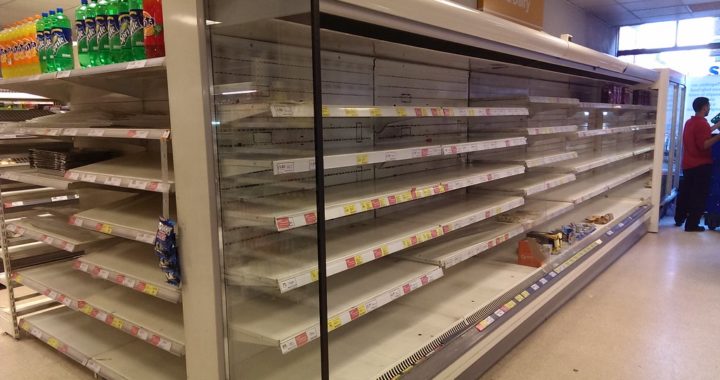‘Government Needs to Step In’: Food Banks Across US Report Unprecedented Demand—and Shortages—as Coronavirus Pandemic Ravages
“We’re seeing people from every socio-economic level because the majority of Americans live paycheck to paycheck.”
By Julia Conley
As 6.6 million Americans filed jobless claims last week—part of at least 10 million people in the U.S. who are out of work in the last two weeks due to the coronavirus pandemic—increasingly long lines at food banks across the country offered another grim illustration of the financial realities faced by the poor and working classes in the United States.
According to an investigation by The Guardian, demand at food banks has increased by eight times in some areas. About a third of people interviewed by the outlet at food banks last month had never before needed food assistance.
Kristin Warzocha, CEO of the Greater Cleveland Food Bank, said the trend was not surprising considering the precarious circumstances working Americans are accustomed to living in, with 78% of workers living paycheck to paycheck and 45% reporting that they have no savings account.
“We’re seeing people from every socio-economic level because the majority of Americans live paycheck to paycheck,” Warzocha told The Guardian.
The coronavirus, officially known as COVID-19, spread to every state in the U.S. in March and drove governments in 38 states to direct nearly 300 million people to stay home—forcing businesses across the country to close and lay off or furlough workers.
In Cleveland, The Guardian spoke with first-time food bank visitors including a freelance photographer, a woman who worked in the hospitality industry, and a cab driver.
At St. Mary’s Food Bank in Phoenix, Arizona, spokesman Jerry Brown reported that “people who knew about us because they donated or volunteered are coming in for food.”
“The 2008 recession doesn’t touch this,” Brown told The Guardian. “It’s a different ballgame.”
On social media, a number of media outlets detailed unprecedented demand and supply shortages at food banks in Florida, Arizona, and Pennsylvania—where Pittsburgh Post-Gazette photographer Andrew Rush posted an aerial view of hundreds of cars lined up outside the Greater Community Food Bank in Duquesne.
Hundreds of cars wait to receive food from the Greater Community Food Bank in Duquesne. Collection begins at noon. @PghFoodBank @PittsburghPG pic.twitter.com/94YFaO7dqX
— Andrew Rush (@andrewrush) March 30, 2020
CORONAVIRUS:
The Arizona National Guard stepped up its efforts to bolster the supply of food Thursday, as a few dozen soldiers packed boxes at food banks seeing a surge in demand. The U.S. so far has reported 93,427 COVID-19 cases, and 1,385 deaths.
(AP) pic.twitter.com/suEupAoha4
— The Voice of America (@VOANews) March 27, 2020
Produce is rotting on the vine in South Florida, but the demand at food banks is higher than ever. At a recent food giveaway in Miami, the line of cars was eight miles long. Incredible story by @Carlos_Frias & @KevinGHall https://t.co/r0rpT1wkK1
— Alex Harris (@harrisalexc) March 31, 2020
The food bank in Greater Pittsburgh reported it received more than 1,000 calls from people in need of assistance in the past two weeks. Ninety percent of the calls were from people who were newly unemployed.
In Massachusetts, a pantry in Amherst distributed 849% more food in March than it did last year.
The high demand at the nation’s food banks comes as some Americans await a means-tested one-time payment of $1,200 per adult—a figure that is projected to last the average household less than two weeks in the midst of a crisis that could go on for several months.
In order to support the rising number of Americans facing job loss and food-insecurity, Kellie O’Connell of the Lakeview pantry in Chicago told The Guardian, the federal government must take responsibility for ensuring working people in the wealthiest country in the world don’t go hungry.
“Philanthropy and not-for-profits are not going to be able to meet food demands,” O’Connell said. “The government needs to step in.”
licensed under a Creative Commons Attribution-Share Alike 3.0 License.
